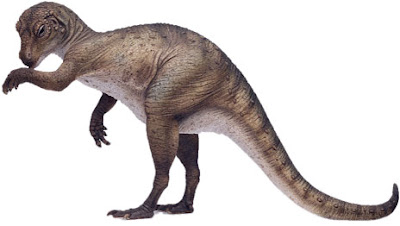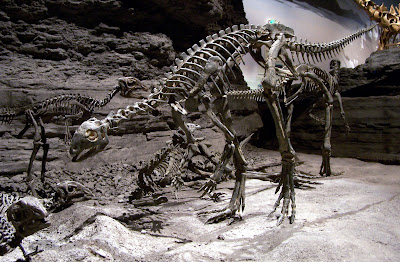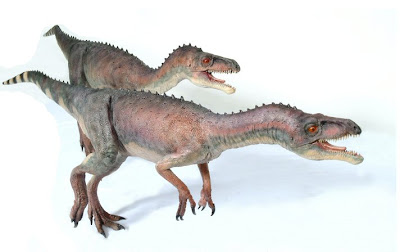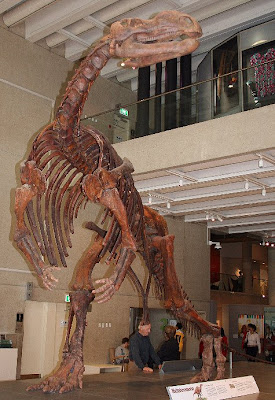
Dromaeosaurids are known throughout the Cretaceous and from North and South America, Europe, Asia, Africa, and Madagascar.
Basal dromaeosaurs (Unenlagiinae and Microraptorinae) include some crow- to turkey-sized taxa: Rahonavis of the Late Cretaceous of Madagascar (and initially thought to be a bird); Microraptor of the Early Cretaceous of China (the first eumaniptoran for which the tail feathers were known); long-snouted Buitreraptor of Late Cretaceous Argentina; and others. Not all of these were small, however. One of the most unusual of these basal dromaeosaurids is giant Austroraptor of the mid Late Cretaceous of Argentina: a long-snouted, short-armed polar bear-sized unenlagiine.
The more derived dromaeosaurids (Saurornitholestinae, Deinonychus, Velociraptorinae, and Dromaeosaurinae) form a group called Eudromaeosauria. These were coyote-to-grizzly bear sized. Well-studied examples include coyote-sized Velociraptor of the Late Cretaceous deserts of Mongolia; wolf-sized Deinonychus of the Early Cretaceous of western North America; lion-sized Achillobator of mid-Late Cretaceous Asia; and grizzly-sized Utahraptor of the Early Cretaceous of western North America, at present the largest known eumaniraptoran.
Dromaeosaurid caudals were more tightly interlocked than in typical theropods, and in microraptorines and eudromaeosaurs extensions from the chevrons and neural arches grew extremely long. The tail was thus an extreme dynamic stabilizer.
Some basal dromaeosaurids had elongate metatarsi (indeed, they have a primitive form of the arctometatarsus), but the majority had relatively short stout metatarsi and tibiae. This suggests that they had sacrificed speed, perhaps for agility (better able to turn quickly while pursuing prey or escaping predators, especially with the help of the stiffened tail). Despite certain books and movies to the contrary, the dromaeosaurids show no signs of being speed specialists.
While the small primitive forms may have eaten small prey (skewering it with the sickle claw in the manner of modern secretary birds, perhaps), the larger forms were predators of dinosaurs. The "Fighting Dinosaurs" specimen of Velociraptor shows it in combat with Protoceratops, the hands used to grasp the head of the herbivore while the sickle claw was ripping into the throat: very similar to the attacks used by large cats. Some (contraversial) evidence suggest that Deinonychus may have attacked the much larger iguanodontian Tenontosaurus in groups (packs or mobs).
Note that the sickle claw may have also been used to climb: either up trees, or up the sides of victims! Additionally, they may have been used to pin smaller prey down on the ground while the jaws and hand claws were used to kill it.

At least some of the early forms may have had limited flight capability: indeed, they show somewhat better flight adaptations than Archaeopteryx! The majority of dromaeosaurids, however, probably lived their lives on the ground (although hiding/sleeping in the trees may have been possible, especially for juveniles).
In the Early Cretaceous dromaeosaurids were major mid-sized predators, and in the deserts of Late Cretaceous Asia they were among the largest carnivorous dinosaurs present. However, with the rise of the tyrannosaurids large-bodied dromaeosaurids disappear in the Northern Hemisphere, and the Late Cretaceous dromaeosaurids of Asia and North America were fairly small animals.
 Troodon is a relatively small, bird-like dinosaur from the Late Cretaceous period. Found in 1855, it was the first dinosaurs found in North America. Its species ranged widely, with fossil remains recovered from as far north as Alaska and as far south as Wyoming and even possibly Texas and New Mexico.Troodon formosus (from Greek troo - to wound and odon - tooth) was a small possibly maniraptoran theropod dinosaur whose eating habits are still uncertain. This taxon is commonly recognized during excavation from its distinctive small teeth with large denticles along the trailing margin. While the dinosaurs may have ranged upwards to 6 feet (2 meters) in length, many of them must have been the size of chickens or smaller. The teeth size nearby microsites (localities in which most of the fossils are  small, being less than an inch, or 2 cm in length. These fossils are often teeth) are nearly microscopic, ranging upward to a few mm in length. Why the teeth are so small is difficult to understand, unless they are from very young dinosaurs that might have been feasting on the rotting carcasses of Edmontosaurus.
Troodon is a relatively small, bird-like dinosaur from the Late Cretaceous period. Found in 1855, it was the first dinosaurs found in North America. Its species ranged widely, with fossil remains recovered from as far north as Alaska and as far south as Wyoming and even possibly Texas and New Mexico.Troodon formosus (from Greek troo - to wound and odon - tooth) was a small possibly maniraptoran theropod dinosaur whose eating habits are still uncertain. This taxon is commonly recognized during excavation from its distinctive small teeth with large denticles along the trailing margin. While the dinosaurs may have ranged upwards to 6 feet (2 meters) in length, many of them must have been the size of chickens or smaller. The teeth size nearby microsites (localities in which most of the fossils are  small, being less than an inch, or 2 cm in length. These fossils are often teeth) are nearly microscopic, ranging upward to a few mm in length. Why the teeth are so small is difficult to understand, unless they are from very young dinosaurs that might have been feasting on the rotting carcasses of Edmontosaurus.















 ronment similar to some of the large plains of Africa today (Russell, 1989).
ronment similar to some of the large plains of Africa today (Russell, 1989).










